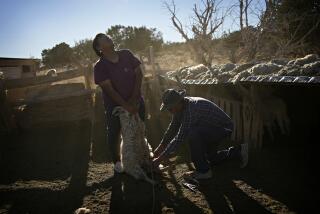All the news from Amish country
- Share via
The latest edition of the Budget had just hit newsstands and Amish family mailboxes, and already fresh updates were pouring in.
“Canning is coming to a close,” one person reported from Salem, Mo. “The weather is very humid to hot today,” wrote another from Grabill, Ind.
The big news from Cottage Grove, Tenn.: “Thomas Hostetler hurt his ankle while loading grain onto the truck from the grain cart.”
The Budget is not your typical newspaper. Since 1890, it has served as the primary communication link among Amish settlements across the country.
And at a time when papers big and small are struggling amid plummeting circulation and intense online competition, the Budget is holding steady. The vast majority of the paper’s reporters -- called scribes -- are Amish and Mennonite volunteers, hundreds of men and women who send handwritten dispatches in from rural outposts. Their only payment is a free subscription, worth $42 a year.
They send their dispatches by mailbag, buggy and the occasional fax to the paper’s office in Sugarcreek (population 2,100), a town 52 miles south of Akron whose downtown is lined with Swiss-style architecture and horse-and-buggy hitching rails.
The town, and the four-county stretch surrounding it, is home to the country’s largest population of Amish, known for their simple, devout lifestyle and their eschewing of modern technologies.
Though a couple hundred subscribers have dropped the paper, advertisers -- many of whom are Amish or Mennonite -- have refused to shift to online advertising. At least 80% of the weekly’s 19,000 subscribers live without electricity or phones.
A typical issue of the Budget includes 44 to 48 pages of chatty letters, each page a block of print with updates on flooded fields and hungry deer, newborn babies and unexpected deaths.
“You may not believe it, but there’s a lot happening out here,” said publisher Keith Rathbun, who mails the paper out to readers across North America and to a smattering of Amish missionaries living overseas.
The paper was founded by an Amish farmer and purchased in the 1920s by a local Lutheran, Samuel Allan Smith.
Smith’s son George realized that non-Amish residents in the surrounding rural areas were hungry for local news of their own. So he divided the paper into two editions.
Today the local version, written by a paid staff of 16, is devoted to local news and sports stories. The scribes’ letters make up the national edition, mailed out to readers.
The loyal Amish-Mennonite readership attracted Rathbun, 57, a newspaper journeyman who had spent the majority of his career at the Cleveland-based Scene Entertainment Weekly.
He had been ready to retire in 2000, but the chance to preserve the Budget and expand its local edition, as well as gain insight into the Amish community, persuaded him to take the job as publisher.
“I find the stories they tell are fascinating,” said Rathbun, who is also a part owner of the publication.
It’s not easy maintaining that delicate balance for the paper’s paid staff, two of whom are Mennonite and none of whom are Amish. After a staff writer wrote about spending a Sunday finishing up a column at the Budget offices, Rathbun received letters chastising him and the employee for working on the Sabbath.
“It’s best just to watch it,” said national editor Fannie Erb-Miller, who is Mennonite and edits the scribes’ letters. “Even I miss things.”
On a recent morning, Erb-Miller hefted the latest delivery of handwritten dispatches onto her desk inside the wood-paneled, early 20th century house. The stack is nearly 8 inches thick. They are handwritten on pads provided by the Budget.
The letters described Dan L. Yoder’s hospitalization from a tumor in his leg, and the difficulty of chasing away hungry raccoons from ripening crops.
A scribe from Strawberry, Ark., wrote of rainy days and how the local teachers were getting ready for school to begin: “Teacher Ramona and her sisters got the upper grade classroom all decked out with a camping theme. Colorful bears and tents and pine trees march across the walls.”
From Waterloo, N.Y., came the news that Wilbur Schmucker has a new silo and Reuben Eicher, 11, is recovering from being kicked in the face by a horse: “After several surgeries and wearing a neck brace for several weeks, he looks to be recovered pretty good, although minus his front teeth.”
“When you read their letters, you kind of feel like you know them,” Erb-Miller said. “In the broader sense, the paper is documenting their day-to-day life, creating a historical record of Amish life.”
It’s also providing news that residents are eager to read. A few miles west of the paper’s office, Amish farmers Thomas Miller and Karl Yoder leaned against wooden bleachers inside the barn at the Mount Hope Auction and studied the lambs and goats being sold.
“Can’t believe it’s still raining out west,” said Miller, 49. “The Budget says that tomato blight’s bad too.”
That such farming updates are at least several days old, from the time the scribe writes the letter to when the Budget prints it, doesn’t matter, Yoder said.
“We don’t need the news that comes from TV,” said Yoder, 51. “This is news we care about, and it comes fast enough for us.”
--
More to Read
Sign up for Essential California
The most important California stories and recommendations in your inbox every morning.
You may occasionally receive promotional content from the Los Angeles Times.













